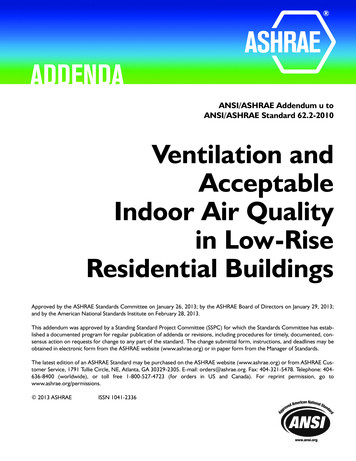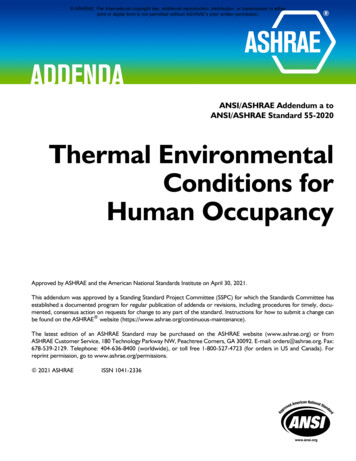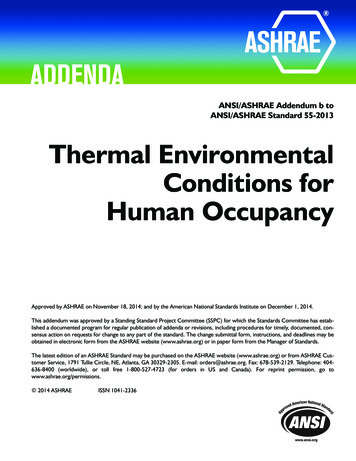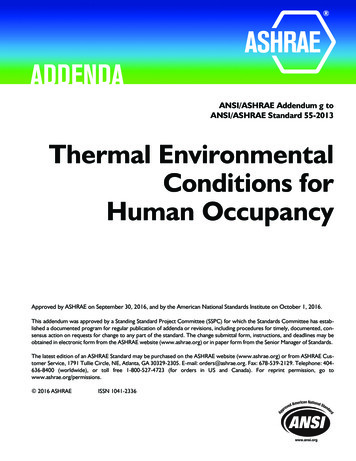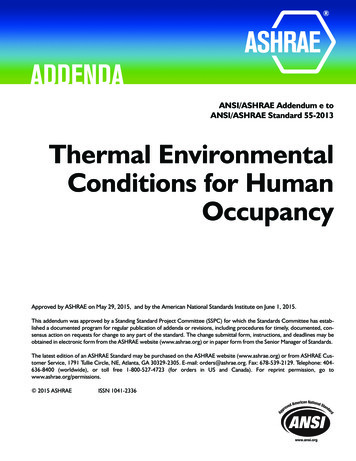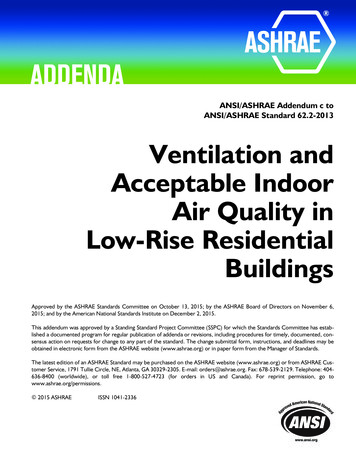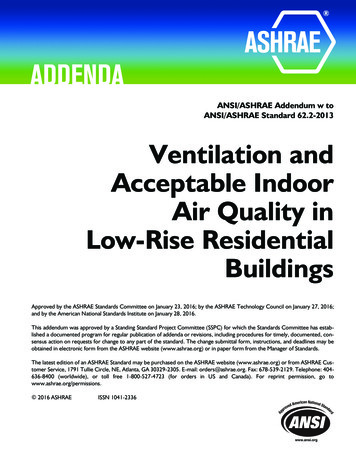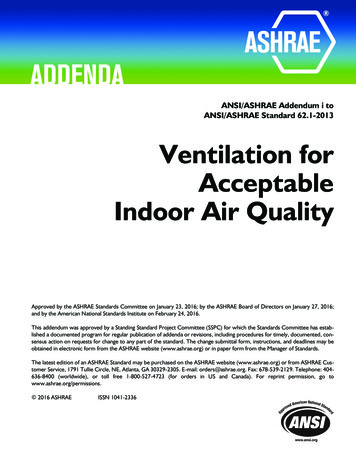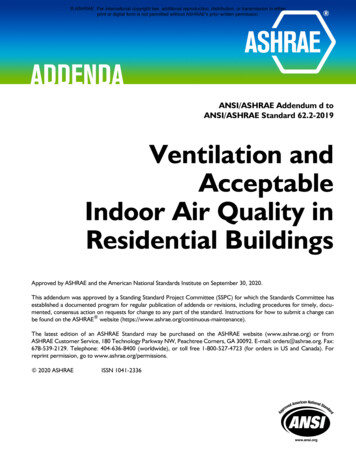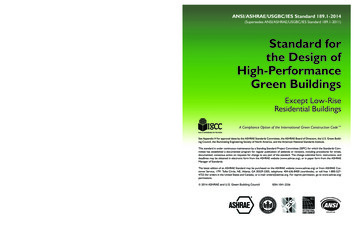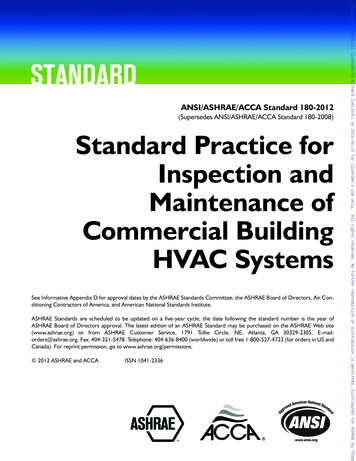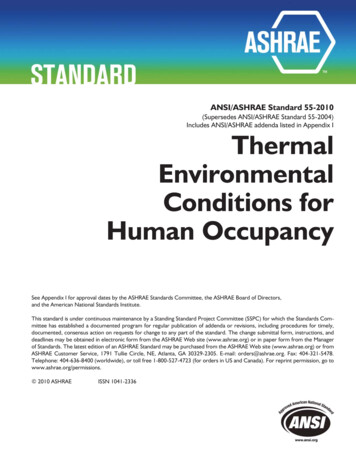
Transcription
ANSI/ASHRAE Standard 55-2010(Supersedes ANSI/ASHRAE Standard 55-2004)Includes ANSI/ASHRAE addenda listed in Appendix IThermalEnvironmentalConditions forHuman OccupancySee Appendix I for approval dates by the ASHRAE Standards Committee, the ASHRAE Board of Directors,and the American National Standards Institute.This standard is under continuous maintenance by a Standing Standard Project Committee (SSPC) for which the Standards Committee has established a documented program for regular publication of addenda or revisions, including procedures for timely,documented, consensus action on requests for change to any part of the standard. The change submittal form, instructions, anddeadlines may be obtained in electronic form from the ASHRAE Web site (www.ashrae.org) or in paper form from the Managerof Standards. The latest edition of an ASHRAE Standard may be purchased from the ASHRAE Web site (www.ashrae.org) or fromASHRAE Customer Service, 1791 Tullie Circle, NE, Atlanta, GA 30329-2305. E-mail: orders@ashrae.org. Fax: 404-321-5478.Telephone: 404-636-8400 (worldwide), or toll free 1-800-527-4723 (for orders in US and Canada). For reprint permission, go towww.ashrae.org/permissions. 2010 ASHRAEISSN 1041-2336
ASHRAE Standing Standard Project Committee 55Cognizant TC: TC 2.1, Physiology and Human EnvironmentSPLS Liaison: Kenneth W. CooperStephen C. Turner, ChairGwelen Paliaga, Vice-ChairBrian M. Lynch, SecretaryEdward A. ArensRichard M. AynsleyRobert BeanGail S. BragerJoseph J. DeringerSahar Abbaszadeh FardJulie M. FergusonJohn M. Filler, Jr.Yanzheng GuanThomas B. HartmanJaap J. HogelingDaniel Int-Hout, IIIEssam Eldin KhalilAlison G. KwokHal LevinHans F. LevyKiymet Ozgem OrnektekinMichael P. O’RourkeNicholas B. RajkovichLawrence J. SchoenChandra SekharPeter SimmondsJerry M. SipesElia M. SterlingJohn L. StoopsBenjamen P. SunSteven T. TaylorRobert W. TinsleyJorn ToftumASHRAE STANDARDS COMMITTEE 2009–2010Steven T. Bushby, ChairH. Michael Newman, Vice-ChairDouglass S. AbramsonRobert G. BakerMichael F. BedaHoy R. Bohanon, Jr.Kenneth W. CooperK. William DeanMartin DieryckxAllan B. FraserNadar R. JayaramanByron W. JonesJay A. KohlerCarol E. MarriottMerle F. McBrideFrank MyersJanice C. PetersonDouglas T. ReindlLawrence J. SchoenBoggarm S. SettyBodh R. SubherwalJames R. TaubyJames K. VallortWilliam F. WalterMichael W. WoodfordCraig P. WrayWayne R. Reedy, BOD ExOThomas E. Watson, COStephanie Reiniche, Manager of StandardsSPECIAL NOTEThis American National Standard (ANS) is a national voluntary consensus standard developed under the auspices of ASHRAE.Consensus is defined by the American National Standards Institute (ANSI), of which ASHRAE is a member and which has approved thisstandard as an ANS, as “substantial agreement reached by directly and materially affected interest categories. This signifies the concurrenceof more than a simple majority, but not necessarily unanimity. Consensus requires that all views and objections be considered, and that aneffort be made toward their resolution.” Compliance with this standard is voluntary until and unless a legal jurisdiction makes compliancemandatory through legislation.ASHRAE obtains consensus through participation of its national and international members, associated societies, and public review.ASHRAE Standards are prepared by a Project Committee appointed specifically for the purpose of writing the Standard. The ProjectCommittee Chair and Vice-Chair must be members of ASHRAE; while other committee members may or may not be ASHRAE members, allmust be technically qualified in the subject area of the Standard. Every effort is made to balance the concerned interests on all ProjectCommittees.The Manager of Standards of ASHRAE should be contacted for:a. interpretation of the contents of this Standard,b. participation in the next review of the Standard,c. offering constructive criticism for improving the Standard, ord. permission to reprint portions of the Standard.DISCLAIMERASHRAE uses its best efforts to promulgate Standards and Guidelines for the benefit of the public in light of available information andaccepted industry practices. However, ASHRAE does not guarantee, certify, or assure the safety or performance of any products, components,or systems tested, installed, or operated in accordance with ASHRAE’s Standards or Guidelines or that any tests conducted under itsStandards or Guidelines will be nonhazardous or free from risk.ASHRAE INDUSTRIAL ADVERTISING POLICY ON STANDARDSASHRAE Standards and Guidelines are established to assist industry and the public by offering a uniform method of testing for ratingpurposes, by suggesting safe practices in designing and installing equipment, by providing proper definitions of this equipment, and by providingother information that may serve to guide the industry. The creation of ASHRAE Standards and Guidelines is determined by the need for them,and conformance to them is completely voluntary.In referring to this Standard or Guideline and in marking of equipment and in advertising, no claim shall be made, either stated or implied,that the product has been approved by ASHRAE.
PrefaceWhat would the world look like without ASHRAE Research? Since its beginnings in 1919,ASHRAE Research has grown and expanded to address the ever changing questions and topicsfacing both its members and the HVAC&R Industry and the world as a whole. ASHRAEStandards are constantly evolving to address these new challenges, fueled by the knowledgeand principals developed through ASHRAE Research. As the focus of the industry has evolvedfrom home refrigeration and food safety to improved indoor air quality to sustainability andenergy efficiency, ASHRAE Standards continue to be the foremost authority in every ASHRAEMember’s career.The power behind ASHRAE Research and ASHRAE Standards comes directly from YOU: yourfinancial support is the driving force behind every research project conducted world wide; yourfinancial investment is an investment in the future of the HVAC&R industry; your donation toASHRAE Research has produced more than 120 ASHRAE Standards.What would an ASHRAE Standard look like without your support of ASHRAE Research? Take alook at just one and imagine a world without this guidance from ASHRAE over the last 90 years.Thank you for all your supportResearch Promotion CommitteeReprinted and altered with the written permission of ASHRAE and for chapter distribution only.The publication may not be reproduced without permission from ASHRAE RP Fundraising Staff.404/636-8400 or researchpromotion@ashrae.org1791 Tullie Circle, Atlanta GA 30329
American Society of Heating, Refrigerating and Air-Conditioning Engineers, Inc. (www.ashrae.org). For personal use only.Additional reproduction, distribution, or transmission in either print or digital form is not permitted without ASHRAE’s prior written permission.(This foreword is not part of this standard. It is merelyinformative and does not contain requirements necessaryfor conformance to the standard. It has not beenprocessed according to the ANSI requirements for astandard and may contain material that has not beensubject to public review or a consensus process.)The 2010 edition of the standard includes the followingsignificant changes: FOREWORDANSI/ASHRAE Standardd 55-2010 is the latest edition ofStandard 55. The 2010 edition combines Standard 55-2004and the ten approved and published addenda to the 2004edition intoi one easy-to-use, consolidated standard. The standard outlines conditions in which a specified fraction of theoccupants will find the environmentrthermally acceptable. Thestandard is intended for use in design, commissioning, andtesting of buildings and other occupied spaces and their HVACsystems and for the evaluation of thermal environments.Because it is not possible to prescribe the metabolic rate ofoccupants, and because of variations in occupant clothinglevels, operating setpoints for buildings cannot practically bemandated by this standard.d 55 was first published in 1966 and republishedStandardin 1974, 1981, and 1992. Beginning in 2004, it is now updatedon a regular basis using ASHRAE’s continuous maintenanceprocedures. According to these procedures, Standard 55 isicontinuously revised by addenda that are publicly reviewed,approved by ASHRAE and ANSI, and published and posted forfree on the ASHRAE Web site.As with previous updated editions of the standard, the2004 edition introduced significant changes. Perhaps mostnotable were (1) the adoption of the computer model methodg the standardfor general indoor application, which broughtinto close agreement with ISO Standards 77261 and 77302, and(2) the introduction of the Adaptive Method, which relied onrecent research to support natural ventilation designs for moresustainable, energy efficient, and occupant-friendly designs.Continuing in this spirit of introducing recent researchinnovations into the standard, several significant improvements have been made in the years since 2004. In particular,the use off elevated air speeds to widen the acceptable range ofthermal conditions has been introduced and refined.The standard previously allowed modest increases inoperative temperature beyond the PMV-PPD (“ComputerModel Method” in the standard) limits as a function of airspeed and turbulence intensity. But field studies, includingrecently published work, show that occupants, especiallywhen neutral or slightly warm, prefer higher air speeds thanwere previously allowed. In certain combinations of temperature ranges and personal factors, the preference for more airmovement is greater than for less air movement. Addendasince 2004 included a new method for expressing and selecting air-speed limits, and alternatives for determining theboundaries of comfort at air speeds above 0.15 m/s (30 fpm).With these changes, the standardd continues to focus on defining the range of indoor thermal environmental conditionsacceptable to a majority of occupants, but accommodates anever increasing variety of design solutions intended both toprovide comfort and to respect today’s imperative for sustainable buildings.2 Clarifies that the upper humidity limit shown on the psychrometric chart in the Graphic Comfort Zone Methodapplies to only that method. Higher humidity limits areallowed if evaluated with the Computer Model Methodand no limits are imposed on the Adaptive Model.Revises requirements and calculation methods whenincreased air movement is used to maintain comfort inwarm conditions. Standard Effective Temperature (SET)is reintroduced into the Standard as the calculationbasis for determining the cooling effect of air movement.In general, the calculation method has been simplifiedwith the removal of turbulence intensity and draft riskcalculations, and the personal control limitations havebeen relaxed based on the results of new research. Thischange is expected to give clear requirements for application of ceiling fans for comfort cooling.Significant revisions to Section 6, “Compliance” thatnow clearly state the mandatory minimum requirementsfor analysis and documentation of a design to show thatit meets the requirements in the standard. InformativeAppendix G expands on Section 6 by providing a compliance form for documentation of design compliance.A new general satisfaction survey has been added tosection 7.5.2.1 as a method to evaluate thermal comfortin occupied spaces. The previous survey in the 2004 version of the standard was meant for evaluating comfort ata point in time (e.g., “how do you feel right now?”), andthe new survey is meant to evaluate the overall comfortof a space (e.g., “how do you feel in general?”). Addition of a general satisfaction survey aligns standard 55with current practice for survey-based post occupancyevaluations (POEs).Editorial changes have been made throughout to clarifythe requirements in the standard. Wherever possible, theuse of informative language in the standard is avoided.For more specific information on the changes and onother revisions made to the standard by addenda, refer toI atInformative AppendixAa the end of this standard. Users of thestandard are encouraged to use the continuous maintenanceprocedure to suggest changes for further improvements. Aform for submitting change proposals is included in the backd 55 wof this edition. Thee project committee ffor Standardwill takeformal action on all change proposals received.1. PURPOSEThe purpose of this standard is to specify the combinations of indoor thermal environmental factors and personalfactors that will produce thermal environmental conditionsacceptable to a majority of the occupants within the space.2. SCOPE2.1 The environmental factors addressed in this standard aretemperature, thermal radiation, humidity, and air speed; thepersonal factors are those of activity and clothing.ANSI/ASHRAE Standard 55-2010
American Society of Heating, Refrigerating and Air-Conditioning Engineers, Inc. (www.ashrae.org). For personal use only.Additional reproduction, distribution, or transmission in either print or digital form is not permitted without ASHRAE’s prior written permission.2.2 It is intended that all of the criteria in this standard beapplied together since comfort in the indoor environment iscomplex and responds to the interaction of all of the factorsthat are addressed.2.3 This standard specifies thermal environmental conditions acceptable for healthy adults at atmospheric pressureequivalent to altitudes up to 3000 m (10,000 ft) in indoorspaces designed for human occupancy for periods not lessthan 15 minutes.2.4 This standard does not address such nonthermal environmental factors as air quality, acoustics, and illumination orother physical, chemical, or biological space contaminantsthat may affect comfort or health.3. DEFINITIONSadaptive model: a model that relates indoor design temperatures or acceptable temperature ranges to outdoor meteorological or climatological parameters.average
ANSI/ASHRAE Standard 55-2010 is the latest edition of Standard 55. The 2010 edition combines Standard 55-2004 and the ten approved and published addenda to the 2004 edition into one easy-to-use, consolidat ed standard. The stan-dard outlines conditions in which a specified fraction of the occupants will find the environment thermally acceptable. The standard is intended for use in design .File Size: 1MBPage Count: 41
